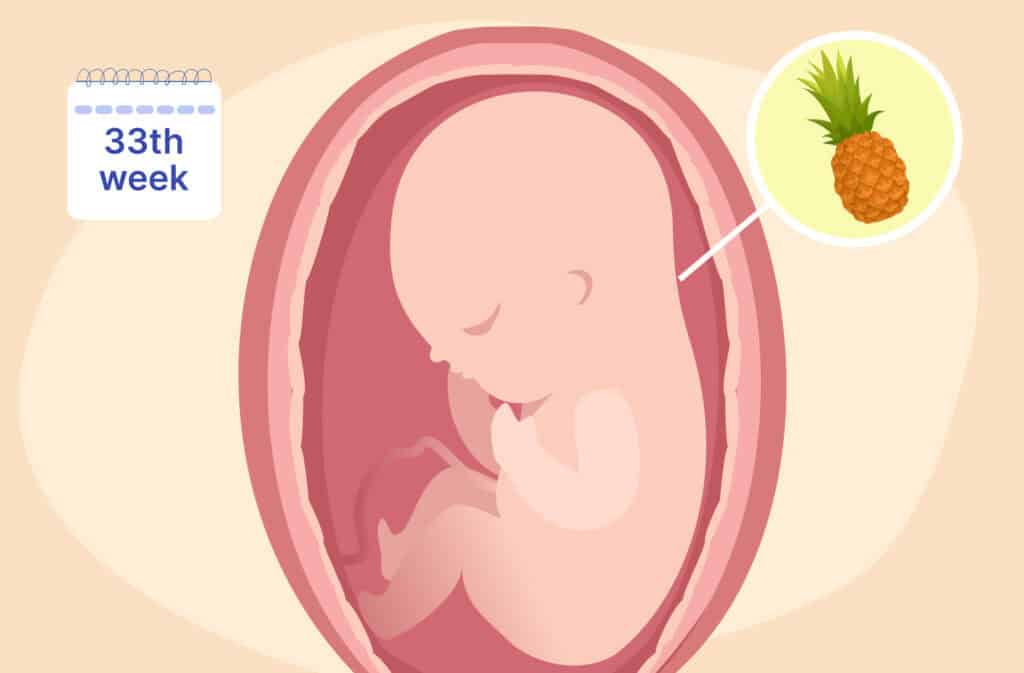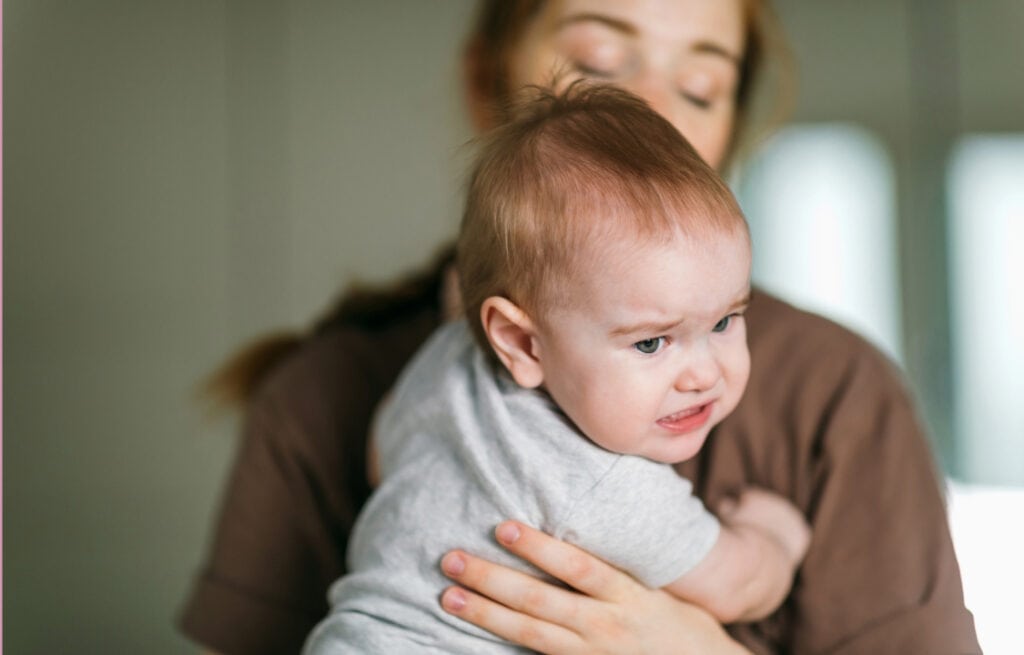Femia > Health Library > Pregnancy > Pregnancy week by week > 33 Weeks pregnant: Fetal milestones, labor prep, and decision-making
33 Weeks pregnant: Fetal milestones, labor prep, and decision-making

- Updated Feb 14, 2025
- Published
CRAFTED BY HUMAN
Crafted by human At Femia, we provide accurate and up-to-date information at every stage of your journey, from trying to conceive, pregnancy and postnatal support. All content is created by a real person based on in-depth research and own professional experience. Femia ensures that you will receive expert advice, strict accuracy and a personalized approach from our authors/medical experts. Learn more about our editorial policy.
FACT CHECKED
Fact checked At Femia Health, we maintain the highest standards of editorial excellence in delivering content focused on helping you conceive, guiding you through pregnancy, and supporting you postpartum. Explore our content review principles to learn how we ensure the accuracy and quality of our health and lifestyle tips for every stage of your journey.
At 33 weeks pregnant, your baby is growing stronger, weighing around 2 kilograms (4.4 pounds), practicing essential survival skills, and settling into position for birth. Meanwhile, you may experience symptoms like Braxton Hicks contractions and swelling.
You’re 33 weeks pregnant and entering the final weeks of your pregnancy! At this stage, your baby is growing rapidly, and getting closer to their birth position. For moms-to-be, symptoms may become more pronounced, and it’s time to finalize your birthing plans. Let’s dive into what’s happening with your baby and your body in week 33 of pregnancy, along with tips for preparing for labor and delivery.
Track your symptoms with Femia and get tailored
health advice right on your phone
Pregnancy symptoms at 33 weeks
Trouble sleeping
As your belly grows and your body adjusts, finding a comfortable position for sleep can become increasingly difficult. Pregnancy-related discomfort, such as back pain and swelling, may disrupt your rest. Anxiety about childbirth or other concerns can also make it hard to relax. To improve sleep, try using a pregnancy pillow, practicing relaxation techniques, and speaking with your healthcare provider about strategies to ease your worries.
Wrist pain
Wrist pain or numbness in your hands can occur due to carpal tunnel syndrome, which is more common in pregnancy due to swelling in the hands and wrists. This condition often worsens in the second or third trimester. To relieve discomfort, try avoiding prolonged positions that strain your wrists, and consult with your doctor if pain persists for recommendations such as occupational therapy or pain management.
Swollen labia
Swollen labia is a normal symptom of pregnancy, caused by increased blood flow and pressure from the growing uterus. While it is typically not painful, it can cause discomfort and itching. To manage this, take breaks from standing or sitting for long periods, wear supportive garments, and apply a cold compress to reduce swelling and discomfort.
Frequent urination
As your pregnancy progresses, frequent urination can become more pronounced, especially during the third trimester due to pressure from your growing uterus on the bladder. To ease the discomfort, reduce fluid intake before bed, avoid caffeinated beverages, and ensure you fully empty your bladder when you go to the bathroom. If you’re experiencing urinary incontinence, consider using panty liners for extra protection.
Shortness of breath
Shortness of breath is common in late pregnancy as the growing uterus presses on the diaphragm and lungs. While mild shortness of breath is normal, severe or persistent symptoms should be addressed with your healthcare provider. If you have a rapid pulse, trouble breathing, or a persistent cough, these may signal a more serious condition requiring medical attention.
Pregnancy brain
Many pregnant women experience forgetfulness and mental fog, commonly referred to as “pregnancy brain.” This is thought to be related to stress, fatigue, and hormonal changes. To manage it, make use of reminders like setting alarms, keeping a to-do list, and simplifying your routine. Don’t be too hard on yourself—getting extra rest and support can help improve focus and memory.
Braxton Hicks contractions vs true labor
| Aspect | Braxton Hicks Contractions | True Labor |
|---|---|---|
| Frequency | Irregular, not progressively closer together | Regular intervals, getting closer together |
| Intensity | Weak, often described as mild discomfort | Increases in strength over time |
| Duration | Short, usually lasting less than 30 seconds | Longer, lasting 30-70 seconds per contraction |
| Location of Pain | Felt mainly in the front of the abdomen | Starts in the back and radiates to the front |
| Effect of Movement | Stops or decreases with activity or a change in position | Continues regardless of movement or position changes |
| Cervical Changes | Does not cause dilation or thinning of the cervix | Causes the cervix to dilate and thin out (effacement) |
33 Weeks pregnant symptoms of labor
- Regular, painful contractions: Unlike Braxton Hicks, these contractions don’t subside with rest and indicate active labor.
- Water breaking: A sudden gush or slow trickle of fluid can signal the start of labor.
- Bloody show: A pink or red mucus discharge may indicate your cervix is dilating.
Your body at 33 weeks pregnant
At 33 weeks, your body is working hard to support your growing baby. As your uterus continues to expand, your belly becomes more prominent, and you may notice the pressure building in your pelvis as your baby settles lower in preparation for birth. The increased weight gain (typically between 20-30 pounds, depending on your pre-pregnancy weight) can cause added strain on your back, hips, and legs, contributing to discomfort as you approach the final weeks of pregnancy.
You might also experience more pronounced movements from your baby, which can feel stronger and more coordinated as they get bigger. With less space to move, you may feel less kicking but more rolling or shifting sensations. These changes can be exciting but also uncomfortable, as the growing baby puts more pressure on your internal organs, including the bladder and stomach. The next few weeks will bring continued growth and preparation for labor, so it’s essential to listen to your body and rest when needed.
33 Weeks in months
You are now approximately 8 months pregnant, with about seven weeks until your due date.
33 weeks pregnant baby position
By this week, your baby is likely moving into a head-down position in preparation for delivery. If they’re not yet head-down, there’s still time for them to turn.
Baby development at 33 weeks
At 33 weeks, your baby is undergoing rapid development as they prepare for life outside the womb. The lungs are maturing quickly, and the brain continues to develop, building neural connections essential for cognitive and sensory functions. Your baby is also practicing breathing movements, inhaling and exhaling amniotic fluid to strengthen the lungs for breathing air after birth. Additionally, fat layers are accumulating beneath the skin, helping to regulate body temperature once your baby is born. These fat stores will help your baby maintain warmth in the outside world.
Baby at 33 weeks
- Weight: Approximately 2 kilograms (4.4 pounds).
- Length: About 17-18 inches long, baby size is similar to a pineapple.
- Movements: As your baby grows, their movements may become more deliberate and noticeable, including distinct kicks, rolls, and stretches. These movements are less frequent but stronger due to the limited space inside the womb.
The next few weeks will be crucial as your baby continues to grow, building strength and weight in preparation for birth.
33-Week ultrasound
A 33-week ultrasound may be performed to check your baby’s growth, position, and amniotic fluid levels. You might also get a detailed view of their facial features or see them practicing movements like thumb-sucking.
33-Week preemie: What to expect
A baby born at 33 weeks is considered moderately premature but has a survival rate of over 98% with appropriate care.
Development and care:
- Lungs: Still developing but may need minimal breathing support.
- Feeding: Feeding assistance, like a tube, may be required initially.
- NICU support: Includes monitoring for temperature regulation and potential infections.
Most babies born at 33 weeks thrive with proper medical care and catch up developmentally with their full-term peers by early childhood.
Track your symptoms with Femia and get tailored
health advice right on your phone
Tests to expect at 33 weeks pregnant
Routine prenatal tests ensure both you and your baby are healthy as you approach delivery:
- Blood pressure check: Detects signs of preeclampsia or hypertension.
- Fetal heartbeat and movements: Your provider will monitor your baby’s activity and heart rate.
- Urine test: Screens for protein and glucose, which can indicate preeclampsia or gestational diabetes.
- Fundal height measurement: Ensures your uterus is growing appropriately.
- Ultrasound (if needed): May be used to monitor your baby’s growth or position.
👉Find out more:
34 Weeks pregnant: Baby development, symptoms, and preterm labor signs
Week 35 pregnancy: Symptoms, baby milestones, and delivery prep
Health tips and self-care at 33 weeks pregnant
Hydrate regularly
Staying hydrated is crucial during pregnancy, especially in the third trimester. Proper hydration helps reduce swelling and supports the increased blood volume, making sure that both you and your baby are getting the nutrients you need. Aim to drink plenty of water throughout the day and try to avoid sugary or caffeinated beverages, as they can contribute to dehydration.
Prepare for labor
As your due date approaches, it’s essential to begin preparing for labor. This is a great time to review your breathing techniques, which can help you stay calm and relaxed during contractions. Practice relaxation exercises such as deep breathing, visualization, and gentle stretches to help relieve stress and tension. Being mentally and physically prepared will help make labor feel more manageable when the time comes.
Support your back
Back pain is a common symptom as your pregnancy progresses. The added weight of your growing baby and changes in posture can put a strain on your back. To help support your back, consider using a maternity belt or lumbar cushion when sitting or standing for long periods. These can provide added comfort and help reduce the strain on your back muscles, making it easier to go about your day.
Track baby movements
At 33 weeks, tracking your baby’s movements is an essential part of monitoring their health. While the American College of Obstetricians and Gynecologists (ACOG) updated their guidelines in 2021, suggesting that routine kick counting is not the primary method for fetal monitoring, it’s still important to be mindful of your baby’s activity. If you notice a significant decrease in movement, contact your healthcare provider right away to ensure everything is okay. Regular monitoring can help detect any potential concerns early.
Questions from the Femia community
How to choose the right birthing option?
Choosing the right birthing option involves understanding your preferences, health needs, and available resources. Discuss options like hospital births, home births, or birthing centers with your provider. Consider factors like access to medical interventions, proximity to care, and your comfort with natural vs. medicated delivery. A flexible birth plan can help you feel prepared while accommodating any necessary changes.
What are the pros and cons of partnering in labor?
Having a partner during labor offers emotional support, comfort, and an advocate for your birth plan. They can help with breathing techniques, encourage you, and communicate with the medical team. However, some partners may feel anxious or overwhelmed, which could affect the dynamic. It’s essential to discuss expectations and involve them in prenatal education to ensure they feel prepared and confident.
What signs indicate preterm labor at 33 weeks?
Signs include regular, painful contractions, a sensation of pelvic pressure, lower back pain, or water breaking. Contact your healthcare provider immediately if you notice any of these symptoms.
What should you not do at 33 weeks pregnant?
Avoid heavy lifting, strenuous physical activity, and long periods of standing. It's important to get adequate rest and avoid stress.
The bottom line
At 33 weeks pregnant, focus on monitoring symptoms like contractions or reduced movements and report any concerns promptly. Finalize your birthing plan, including pain management preferences, and have open discussions with your partner about labor and postpartum roles. Stay healthy with gentle exercise, proper hydration, and a balanced diet. Educate yourself on labor stages and newborn care to feel confident and prepared for the weeks ahead.
References
- “33 Weeks Pregnant: Symptoms, Baby Development & Tips.” BabyCenter, www.babycenter.com/pregnancy/week-by-week/33-weeks-pregnant.
- “Week 33 of Pregnancy: Symptoms, Baby Development & More.” What to Expect, www.whattoexpect.com/pregnancy/week-by-week/week-33.aspx.
- “33 Weeks Pregnant: Baby Development, Symptoms & Tips.” NHS, www.nhs.uk/pregnancy/week-by-week/1-to-12/33-weeks/.
- “Pregnancy Week 33: What to Expect.” American Pregnancy Association, www.americanpregnancy.org/healthy-pregnancy/week-by-week/33-weeks-pregnant/.
- Smith, Jane, et al. “Updated Guidelines on Fetal Movement Monitoring and Its Implications for Practice.” MCN: The American Journal of Maternal/Child Nursing, vol. 49, no. 6, 2024, pp. 321–326. Lippincott Williams & Wilkins, https://journals.lww.com/mcnjournal/pages/articleviewer.aspx?year=2024&issue=11000&article=00002&type=Fulltext. Accessed 14 Nov. 2024.

Why won’t my 7-month-old sleep? Click to learn what a 7-month sleep regression is, what causes it, what the signs are, and how to help your baby sleep better.

After having a baby, it’s normal your sex life changes, especially if you’re breastfeeding. Explore why it does and how to improve your breastfeeding sex.

Learn about missed miscarriages, including common causes, symptoms and management options. Understand the causes and how to support your physical and emotional recovery.

